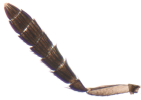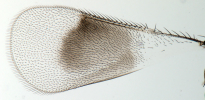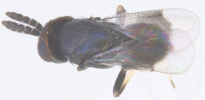Scientific name
Coccophagus ceroplastae (Howard)
Taxonomic position
Hymenoptera: Chalcidoidea: Aphelinidae
Diagnosis
Female: Length: 0.75-1.35 mm. Body dark brown to nearly black, thorax including
scutellum, dark with a distinct metallic violet tinge, gaster dark; vertex with an orange to yellow spot at each posterolateral corner between posterior ocellus, occipital margin and eye margin; antenna
brown to dark brown, scape variable, nearly completely white to as dark as pedicel. Antennal formula 1133, flagellum somewhat flattened. Fore wing hyaline, strongly infuscate behind marginal and
stigmal veins, infuscation distally convex; basal cell with few setae; hind wing hyaline. Legs dark brown including coxae, with apices narrowly of fore and mid femora, largely fore tibiae, distal
one-third to two-thirds of mid tibiae and tarsal segments 1-4 of all legs whitish yellow.
Male: Similar to female except posterior ocellus about one diameter to eye margin. Antenna
with flagellar segments quadrate to very slightly longer than broad, but occasionally all distinctly longer than broad and without a distinct club (slightly modified from Hayat, 1998).
 Antenna
Antenna
 Fore wing venation
Fore wing venation
Image
 Adult female, dorsal view Adult female, dorsal view
Distribution
Cosmopolitan in the Old World tropics. Widely distributed in India, including Andaman & Nicobar islands (Hayat, 1998).
Hosts / Biology
A parasitoid of scales (Hemiptera: Coccoidea), mainly soft scales such as Coccus viridis, C. hesperidum, Saissetia coffeae, Ceroplastes spp., Pulvinaria psidii, P. polygonata (Coccidae), etc. Other scales and mealybugs belonging to Diaspididae and Pseudococcidae have also been recorded as hosts (Hayat, 1998).
Reference
- Hayat, M. 1998. Aphelinidae of India (Hymenoptera: Chalcidoidea): A taxonomic revision. Memoirs of Entomology International, Volume 13. Associated Publishers, Gainesville, Florida, USA. 416 p.
|